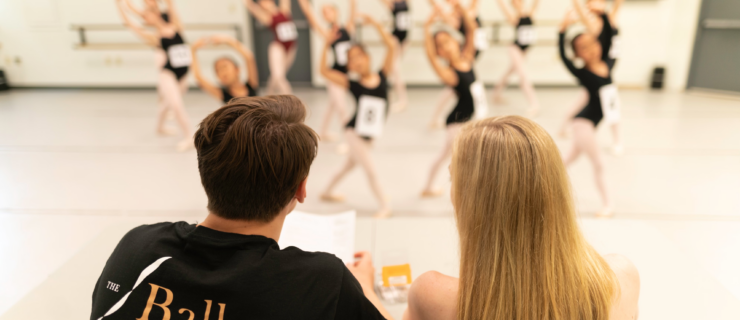Breathtaking Bourrées
When I was a young ballet student, I used to pop in my favorite video of Giselle and quickly fast-forward to Act II to watch Myrta’s famous entrance. A tall, ghostly woman appears from behind the misty trees and bourrées across the length of the stage. Her feet tremble at breakneck speed, while her veiled head remains perfectly level. The effect is astonishing—she is transformed into an ethereal spirit.
Later I would go to pointe class and, channeling my inner Myrta, attempt to bourrée across the floor. The result was a clumsy mess. My steps looked more like gallops, and man, did my feet hurt. I thought bourrées were supposed to be easy!
Bourrées are all over classical ballet, because nothing says “ballerina” better: Their lightness and delicacy ooze femininity. They can also create different impressions depending on how they’re performed—communicating Odette’s fear in Swan Lake, for example, or accentuating the Sylphs’ otherworldliness in Les Sylphides. Though bourrées are difficult to master, once you conquer them, you’ll find that they’re a powerful tool.
The Golden Rule
Mireille Favarel, associate director of Milwaukee Ballet II, says the biggest mistake dancers make during bourrées is leading with their front foot. “Use the back foot to travel,” she says. “Push the back thigh against the front thigh and cross, cross, cross.” Leading with the back foot ensures that your legs will stay close together. You’ll take smaller steps and have a smoother movement quality.
“It’s as if the back leg is chasing the front leg,” says English National Ballet junior soloist Tiffany Hedman, who had to perfect her bourrées for one of the principal variations in “Emeralds” from George Balanchine’s Jewels. “Imagine there’s a quarter between your thighs, and don’t let that quarter fall.”
When traveling forward and backward, imagine overcrossing your fifth position (though you shouldn’t actually overcross). “The front leg is a little more active when you bourrée backwards than when you’re bourréeing to the side or the front,” says Favarel. “It helps push the back leg.”
Small and Supple
Keep the space between your feet small to build speed and maintain smoothness. Large steps create a limping effect that screams, “My feet are killing me!” Not only that, they slow you down. “Think of making tiny little stitches, like a sewing machine,” says Kelly Myernick Kubin, a former dancer and teaching artist with Houston Ballet. “If the movement is small, the upper body can stay on one level.”
In addition to taking tiny steps, let your knees and ankles relax. Stiff, straight legs will not only make you look jerky but will also feel heavier on your feet. Allowing your knees and ankles to bend will take pressure off your toes and keep your upper body from looking stiff and strained.
Your port de bras should appear effortless while your feet are fluttering. This requires expertly timed coordination. “Your arms are moving much slower than your feet,” says Favarel. “You have to disassociate your upper and lower halves from each other.”

Sara Mearns in Swan Lake (photo by Paul Kolnik)
Pain Relief
As the saying goes, we must suffer to be beautiful—and unfortunately, this all too often applies to bourrées. The nature of the step can cause blisters and bruised toenails, so be prepared if you know you’re in for a bourrée-heavy rehearsal.
“Use thicker toe pads than usual, or add some lambswool or paper towels inside the box,” says Hedman. “As your feet get warmer and your shoes get soggier, you’ll sink more into your shoe, so really pack the toe.”
Choose your shoes wisely, too. “It can be deadly to bourrée on soft shoes,” Favarel says. “If the box is too soft, you can bruise your toenail, and if the shank is too soft, you can overstretch the tops of your feet.” A newer pair with a slightly harder shank is usually a better bet. (But you might want to hammer the box to make the new shoes quieter, since bourrées can be noisy.)
Myernick recently experienced firsthand how bourrées can mesmerize an audience. When she performed a series of bourrées as Myrta in Giselle, the crowd suddenly began to applaud. “I was so surprised because it’s not a virtuoso step,” she says. “But if done right, bourrées can be virtuosic.”
Famous Bourrée-ers
Here are four iconic roles that show off the dramatic range of bourées.
Odette in Swan Lake: Odette’s bourées sometimes take on a quivering quality to portray her fear of Prince Siegfried. At other times, they’re more upright, giving the illusion of flight as she flaps her wings.
Raymonda in Raymonda: Raymonda’s wedding variation in Act III consists almost entirely of bourées. They serve as a regal platform for her luxuriously stylized port de bras.
The Sleepwalker in La Sonnambula: In George Balanchine’s La Sonnambula, the Sleepwalker bourrées on pointe in sixth position (turned in) for the majority of her pas de deux with the Poet, which emphasizes her trance-like state—the fact that she’s literally and figuratively on a different plane than the Poet.
Myrta in Giselle: As the leader of the eerie Willis, Myrta does bourrées so fast and smooth that they’re almost imperceptible. She appears to be floating above the ground, which adds to the spooky, ghostly element of her role.
Amy Brandt is the Editor in Chief of
Pointe.




